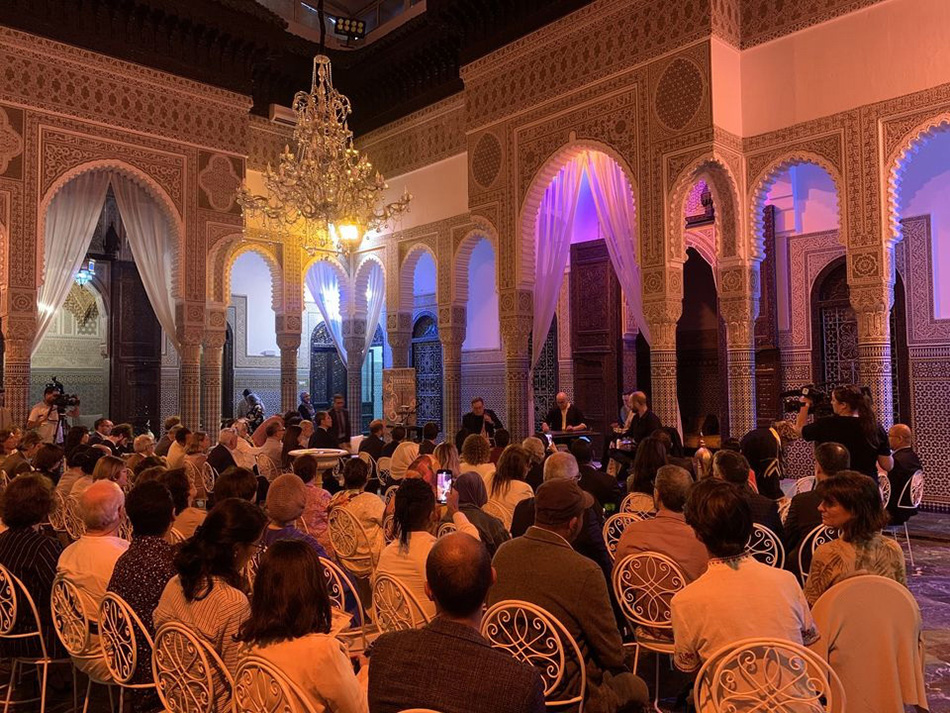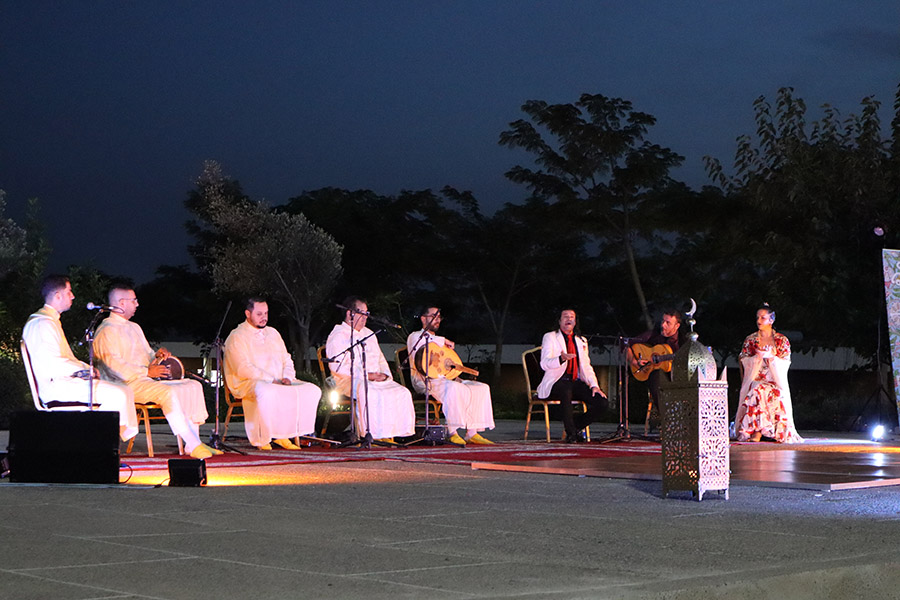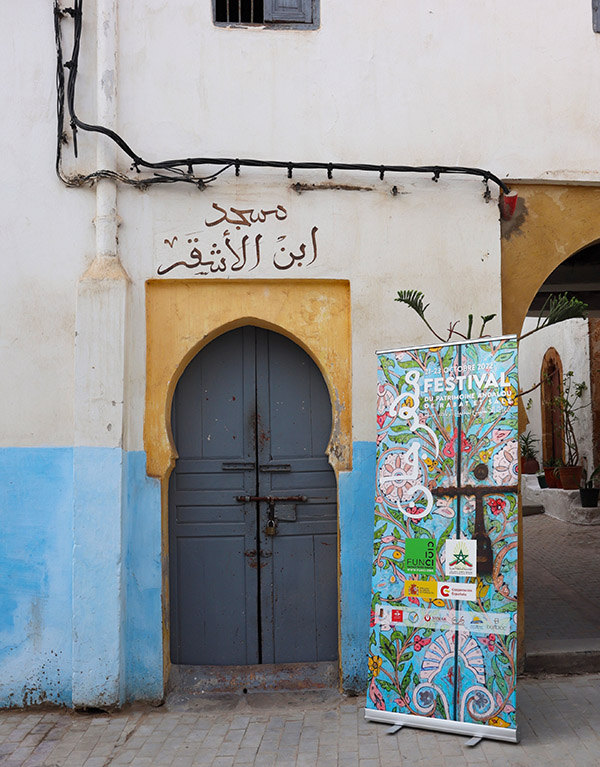Articles, Communications
Al-Andalus for a united Mediterranean
Date of publication of the article: 01/11/2022
Year of publication: 2022
From 21 to 23 October 2022, the Andalusian Heritage Festival of Rabat and Salé (Morocco) was held in various historical and heritage sites in the two cities flanking the Bouregreg estuary. Organised by the Foundation of Islamic Culture in collaboration with the Academy of the Kingdom of Morocco and the Spanish Embassy in Morocco, this event responded to the desire to celebrate the historical and cultural legacy that has united the two banks of the Bouregreg River and the Mediterranean for centuries.
FUNCI is celebrating its 40th anniversary this year, dedicated to building bridges to facilitate understanding between peoples through culture. It therefore wanted to include this event in its agenda, in order to contribute to understanding, particularly between two cities with deep Maghrebi-Andalusian roots, through the centuries. This common heritage, also shared with Spain, has strongly marked the history, architecture, art, crafts and customs of the two cities which, having shared so many vicissitudes and ways of life, have nevertheless looked at each other with a certain neighbourly suspicion for many years.
This common heritage, also shared with Spain, has strongly marked the history, architecture, art, crafts and customs of the two cities.
At present, institutional efforts are focused on rapprochement and ironing out differences – it should not be forgotten that Rabat, being the capital of the Alaouite Kingdom, is the object of the greatest attention – as well as communicating both cities through various infrastructures, such as the tramway and the new bridges to easily cross the Bouregreg estuary.
Moreover, this rich and fertile past is common to both sides of the Strait, in a constant coming and going of migratory flows and dynastic movements. These include the Almoravid and Almohad dynasties, as well as the migrations and expulsions of the Andalusians and Moors who fled the new Castilian conquerors and settled in Salé and Rabat.
This rich and fertile past is common to both sides of the Strait, in a constant coming and going of migratory flows and dynastic movements.
This festival, open to the general public and specialists, included various activities. These included a concert by the Valencian early music group Capella de Ministrers, which performed texts from the famous treatise on love by the Cordovan philosopher Ibn Hazm, “The necklace of the dove” (tawq al-hamama), the millennium of which is celebrated in Spain. There was also an Andalusian-Flamenco fusion concert by the Tetouanese musician and musicologist Amin Chaachoo with his company Medialuna Flamenca, in the peaceful open-air setting of the School of Gardening Med-O-Med, one of FUNCI’s projects in Morocco.
A symposium on the Andalusi past
The Rabat and Salé Andalusi Heritage Festival also included a symposium in which leading specialists in the Andalusi period, such as Hassan Rguig, Mercedes García-Arenal and Leila Maziane, Antonio Almagro and Nabil Rahmouni, Manuel Casares and Mounia Bennani, took part to talk about history, architecture and landscape.
Among the very fruitful speeches, the one by the great specialist Mercedes García Arenal (Consejo Superior de Investigaciones Científicas) on the “cultured” Moors who settled around the Bouregreg, as opposed to those who dedicated themselves to the corsairs, stood out in the block dedicated to history. He recalled figures such as Ahmad al-Hajari, who learned to write Arabic clandestinely in Madrid before going into voluntary exile in Morocco, and who was the author of autobiographical and polemical texts. Also, that of the Toledo-born Ibrahim Taybili, who, expelled to Tunisia, maintained Castilian in his works, and explained the difficulty of the Christian authorities in converting the Moors because “in becoming a Moor one is a Moor by heart”.
FUNCI celebrates its fortieth anniversary this year, dedicated to building bridges to facilitate understanding between peoples through culture. For this reason, it wanted to include this event in its agenda, in order to contribute to understanding, particularly between two cities with deep Maghrebi-Andalusi roots.
Historian Leila Maziane (Mohammed V University of Casablanca) spoke about the social organisation of the Republic of Salé and how, according to the memoirs of Alonso de Contreras, in Hornachos the Moors already formed a de facto republic.
The architect Antonio Almagro presented the magnificent atlas of Almohad architecture Ataral (ataral.es), which provides researchers and the general public with up-to-date, high-quality information on the constructions built under Almohad rule in the Iberian Peninsula and the Maghreb. The veteran specialist pointed out that research financed with public funds must offer results that are accessible to the public and useful to society as a whole, as is the case here.
The botanist from the University of Granada, Manuel Casares, in the panel dedicated to landscape, expanded on the false beliefs surrounding the Andalusi garden, and in particular developed the cliché of the ‘still waters’: the sheets of water such as those in the Patio de los Arrayanes in the Alhambra, which are thought to reflect the buildings that surround them. Casares, on the contrary, showed the historical use of fountains and other devices that made the water flow.
Landscape designer Mounia Bennani spoke of the colonial ‘reinvention’ of the Andalusi garden, and in particular the role of Marshal Lyautey and landscape designer Marcel Zaborsky in the design of the great green spaces of Rabat and the buildings that accompany them.
Families of Andalusi origin and heritage visits
The following day, at Dar Bensaid, a beautiful restored house in Salé, a meeting was held between families from Rabat and Salé of Andalusian origin, animated by Abdelkrim Bennani, President of the Ribat Al Fath association, as well as Majida Bargach and Mekki Zouaoui, with interesting talks, including that of the Moroccan-Dutch journalist and writer Hassnae Bouazza, who spoke about medieval cuisine and referred to the Andalusian manuscript Fadalat el-khiwan (“The reliefs of the table”), by Ibn Razi, translated from Arabic on several occasions.
For his part, Amin Chaachoo polemicised the Andalusian heritage, affirming that 80% of the roots of the music of the Andalusian tradition are Christian, as they come from Hispanic liturgical chant, and he encouraged us to avoid simplistic and identitarian views of a heritage whose richness lies in its complexity. He also pointed out the classist component that has often gone through the claim of Andalusian lineage in Morocco, because it is made in opposition to a mass of the population that is implicitly considered less refined and developed.
The Salé meeting of Moorish descendants explored and illustrated these issues, and also moved towards the long unfinished debate on tradition and modernity and on the integration of the various historical influences that underpin Moroccan society today.
On Sunday 22nd, the association WASL, générations patrimoine, offered a series of guided tours of sites in the two great cities, not always accessible to tourists or known to local inhabitants.
The result of these intense and enjoyable days was an in-depth study of the past that has shaped Rabat and Salé in a special way, dialogue and understanding, and the launching of future initiatives to bring Spanish and Moroccan institutions and scientists closer together in this great adventure that is the knowledge and dissemination of culture.
Also, as the president of FUNCI, Cherif Abderrahman Jah, points out, “to learn to value heritage as a tool at the service of education and development, and to share this stage of history with the new generations, so that they can appropriate it and learn a little better about their past and, therefore, about themselves and their possibilities for the future”.
The Rabat and Salé Andalusian Heritage Festival was organised in collaboration with the Dutch Institute of Morocco, the Cervantes Institute of Rabat, the municipality of Agdal Ryad, the associations Ribat Al Fath, WASL Générations patrimoine and Sala Al Mustakbal, as well as the company Boitaloc.







